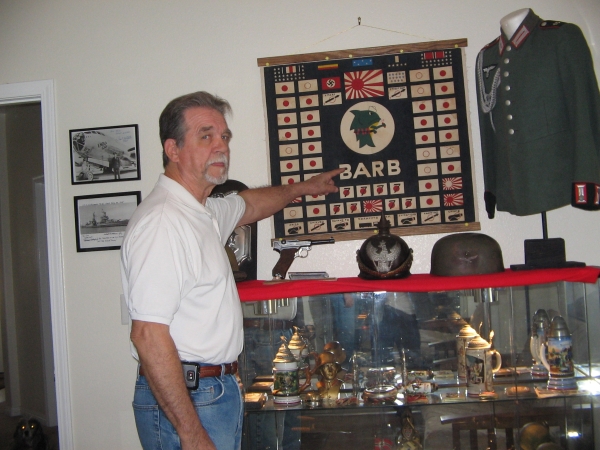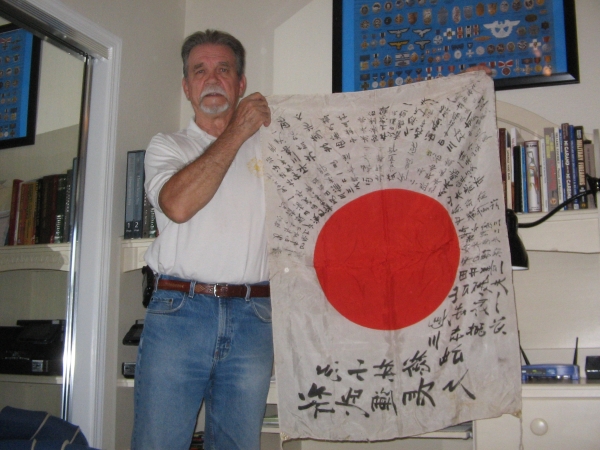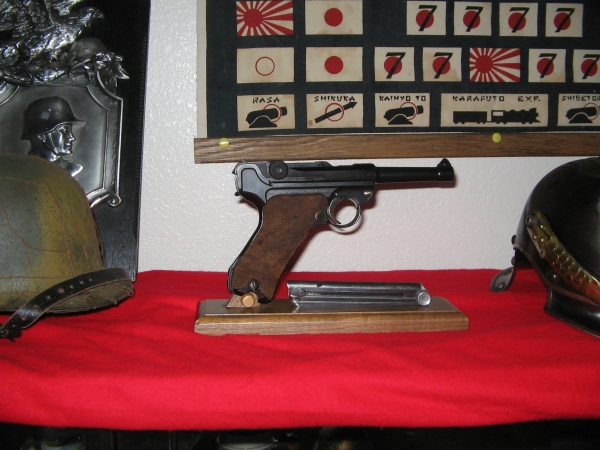War memorabilia collector still seeking ‘home runs’
Jim Krznar always liked history growing up in western Pennsylvania.
He started collecting Civil War items as a teen and that interest flourished into a self-described "serious collector" of military and war relics.
Meeting World War II veterans over the years piqued his interest. Since many of the veterans from that era have items they brought back from the service, it makes them easier to find than Civil War artifacts.
Krznar also has numerous World War I items including a "doughboy" or infantry soldier uniform packed away as part of the vast collection in his home. The items in his display room are just a sampling of the entire collection which he estimates to be hundreds of items.
"I've narrowed it down from quantity over the years to quality," Krznar said. "I have less items now than I might have had 10 years ago, but many more rare items now than I used to have."
One of his most prized items is a flag taken from the submarine USS Barb (SS-220). The submarine has gone down in history for sinking 17 enemy ships with the most tonnage in the Pacific during World War II. Some of the crew were the first Americans to land on Japan and blow up an ammunition train during the night in July, 1945.
According to Krznar, the banner is made out of sailcloth and hand-painted. It shows the crew's victories, the ships they sunk and damaged of all nationalities, mostly Japanese. The flag also has about a dozen little crosses symbolizing the American fliers they plucked out of the ocean after being shot down. The Karafuto Express, the blown up train, is also depicted.
The original flag is on display at the Smithsonian Institute in Washington, D.C. Krznar has the exact same flag, but on a smaller scale. Only 8 or 10 were made by a crew member for the officers on the submarine.
One of Krznar's most valuable finds was at a World World II veteran's yard sale in Pennsylvania in the '80s. Krznar bought a small cardboard box full of German war souvenirs and among them he found some documents written in German inside a red packet with a gold eagle and swastika on the front. When he opened it, Krznar saw a photo of an elderly man wearing a German military uniform. He took the papers to the local high school German teacher for translation. Turns out they were the official papers of Dr. Theodor Morell, Adolph Hitler's personal physician.
Krznar went back to the veteran to ask him how he acquired the documents and if he realized their value and wanted more money.
The vet told Krznar he was only 18 years old when his squad was sent at the end of the war to arrest a German scientist. That's all they were told. His comrades looted the house, but he only took the papers out of a desk.
He was not interested in getting them back or wanting more money. He turned his back and walked away.
Krznar used to display the Morell packet at large military shows and some of the largest collectors in the world wanted to buy it. He didn't sell it for a few years, but eventually turned it over to a military auction in Kansas and it was sold to a European buyer.
Being a veteran himself, having served in the Air Force with two tours of duty in Vietnam, further added to Krznar's interest in collecting, buying and selling war memorabilia even before the Internet. He says it has "ruined the market" by making items too plentiful.
Krznar travels to many military collector shows around the country looking to enhance his treasure trove. He is looking for American, Japanese, Italian and German war items to add to his collection but the majority of inquiries he gets are from people who want to sell German items.
"The reason I may have more German items is because more German items are brought home as souvenirs; they're high quality and the Americans occupied Germany," he said.
"The German items are the highest quality, the medals, the badges, the uniforms, everything and everybody wanted to bring those home along with some Japanese items," he added.
"World War II is the main focal point, I think, for all the souvenirs just because of the quality, really; the European stuff, the Italian, it was real good, real good," Krznar said.
Relics from other wars, including Korea, Vietnam and the Gulf War are not so collectible according to Krznar.
"Korea, there's not a whole lot because the quality of the Korean items, the communist items was very poor," he said. "And the guys didn't bring hardly anything home, the Americans."
He believes even in the future, items from the Vietnam era will never "catch on" as collectible items like those of World War I and II. Patches and uniforms continued to be made by the Vietnamese even after the war ended, flooding the market as souvenirs.
"To pick up a Vietnam patch at a show, you don't know when it was made, in 1965 or 1995 unless you get it from a veteran, a veteran from Vietnam you know, which I am."
Krznar added that even he cannot tell the authentic ones from the fakes.
He said he is always looking to buy high-quality items and weapons like swords, daggers, and Japanese samurai swords with nothing particular in mind.
His ads have been running in Pahrump Valley Times and he got some good leads.
"I do get some good calls," Krznar said. "I bought some good weapons in this town, you know, German weapons and that and historical items.
"I chase every call down," he said. "I go look at everything and if it's common I'll tell them, 'hey it doesn't have much value'."
If you have any military items to sell or for Krznar to appraise, contact him by calling 928-846-1917 or email: krznar109@frontier.com.
Krznar says sometimes he finds a stash of what he and other collectors call a "home run".
"Every once in a while you walk in a house and it's unbelievable what they have," he said. "You know it just happens. Of course, the more times you go look, the better your odds are."
He said he has not found any " home runs" yet in Pahrump, but he's working on it.


















